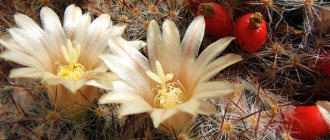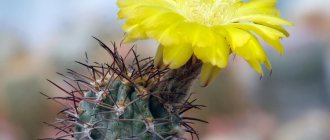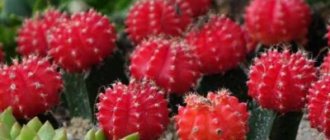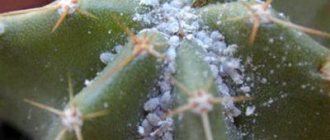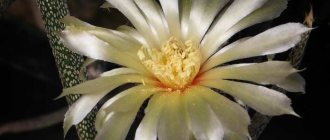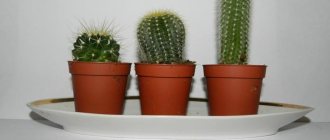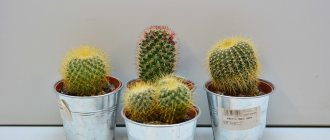Cacti, as you know, are still Spartans among plants. They settle where few survive. They do not need constant soil moisture and are classified as one of the most drought-resistant plants. Some skeptics even argue that there is nothing special to love about cacti: they say, they only have thorns. But apparently, the apologists of this point of view simply never saw how these “Spartans” blossomed. The flowering of cacti is a stunning spectacle that turns the established opinion about “thorns” upside down. Well, are you ready? We have chosen for you a stunning “twenty”, the flowering of which fascinates and makes you fall in love at first sight.
Schlumbergera cactus
The Schlumbergera cactus has several names. For example, it is often called zygocactus. But there is a third - completely popular name: Decembrist. No, no, the flower is in no way connected with the participants in the Russian opposition movement of the beginning of the century before last. The cactus received this name due to the fact that the buds, which ripen on it for a long time, bloom just on the eve of Christmas. Moreover, the flowers on the zygocactus can be painted in the most unexpected colors - from scarlet to soft pink.
The homeland of the Schlumbergera cactus is the tropical forests of Brazil. Although this flower has thorns, it is not as sharp and prickly as its counterparts. The thorns of the zygocactus are soft and delicate.
Video description
In this video, watch the 10 most beautiful cacti for home cultivation:
See also: Catalog of companies that specialize in garden houses and landscape design.
Rhipsalis
Soft woody succulents come from the rainforests of Brazil. They have a large number of stems that hang down in cascades. These cacti grow very quickly, and with proper care you can get a beautiful and voluminous indoor plant in a few years. The rhipsalis genus has more than 60 species, and a very small number of species can be grown at home.
Rhipsalis Barchela has thin cylindrical shoots.
This type of cactus will perfectly complement any composition in the house Source klumba.guru
Rhipsalis hairy is distinguished by thin and long shoots that not only branch, but also twist a little. At the end of autumn, the shoots are covered with small white flowers.
Really resembles hair Source prorostet.ru
Rhipsalis elliptical is a bit like a Christmas tree, but its buds form along the edges of the leaf blades. Flowers painted light yellow.
It should not be confused with the Christmas tree Source worldofsucculents.com
Rhipsalis pilocarpa is distinguished by powerful shoots of a dark green hue, covered with long hairs. Buds form on the shoots several times a year. The flower is white with a slight yellowish tint and has a large number of stamens.
Wonderful home decoration Source i.ytimg.com
Multicolored cacti
Cacti are plants that are susceptible to mutations. Sometimes shoots grow from seeds that do not have chloroplasts - cellular organelles containing chlorophyll.
As a result, the plant not only has an orange, pink or yellow color, but also cannot survive on its own, since it is not able to produce the necessary substances when exposed to sunlight.
In other words, the process of photosynthesis is impossible for such specimens. But, if such a plant is grafted, the rootstock will feed such a plant. For the first time, such experiments began to be carried out in Japan, which is why such cacti are sometimes called Japanese.
Under natural conditions, these cacti die Source i1.wp.com
Almost all types of cacti have seedlings with a mutation without chlorophyll. But the most widespread species are those that grow quickly and have a tendency to reproduce vegetatively, that is, they form many additional children.
The most unpretentious varieties are used for the rootstock Source flowers.evroopt.by
For such plants there is no need to create special conditions - the main thing is that the rootstock is alive. They can be successfully used to decorate any interior or create various compositions.
Each composition is unique Source krrot.net
Rhipsalis
This is another cactus that is impossible to prick yourself on. The stems of rhipsalis are very long and can reach a meter in length. During the flowering period, which, by the way, just like the Schlumberger cactus, occurs in the first month of winter, yellow, pink and snow-white inflorescences appear on these long shoots. Blooming rhipsalis is a stunning and very exotic sight. Two regions located in different parts of the world are considered to be the birthplace of this plant. The first of them is the same Brazil, from which the Schlumbergera cactus comes. And the second is Ceylon, which today is part of Sri Lanka.
In nature, rhipsalis settles on trees and hangs beautifully from them. And in cultural conditions, this plant is often used to decorate balconies.
Rhipsalidopsis
Visually, ripsalidopsis is very similar to Decembrist. And its name is consonant with the previous participant in our top. Meanwhile, ripsalidopsis is an absolutely independent plant, which is popularly often called the Easter flower. And all because the flowering of this non-thorny cactus coincides with the great holiday of Easter. There are more than three thousand species of ripsalidopsis. But there are, of course, significantly fewer cultural varieties. However, even those that exist are very diverse: a distinctive feature of all varietal and hybrid rhipsalidopsis is the bright color of the inflorescences.
Gymnocalycium
A traditional round cactus, which, unlike its previous brethren, has rather dense and dangerous spines. If the conditions you create for growing the gymnocalycium cactus are truly comfortable, then in the second year of its life this “fat little thing” will bloom. Gymnocalycium flowers may differ in color. They come in both crimson and hot pink, yellow, powdery or orange.
Gymnocalycium Michanovich is one of the most popular varieties of this cactus. Not only the flowers are unusual, but also the stem itself, which has a red-brown color that is absolutely uncharacteristic for a cactus.
Parody
cactus body
shiny dark green color. The body of the cactus is spherical or cylindrical, ribbed with frequent small bushy spines. The height of a cactus can be 10-60 centimeters. The flowers are white, pink, light purple, funnel-shaped, wide open, 3-6 centimeters in diameter. Flowers on short pubescent stalks. The flowers are placed on top of the cactus body.
Astrophytum
Speckled Astrophytum, which every self-respecting fan of cacti has in their collection, is very similar to a star in the sky. Actually, it was precisely for this similarity that the Mexicans, who share the same citizenship with the cactus, gave it that name. Astrophytum blooms beautifully: during the flowering period, large single flowers appear on it. But still, the secret of its decorativeness is not in the flowers. The fact is that its stem is covered with multiple white specks, which turn the astrophytum into an impromptu map of the night sky.
Astrophytum variety “Jellyfish Head” looks very strange and unusual. The pattern of white dots on its stem resembles snakes swarming in the head of a mythical creature.
Feeding and fertilizer
The full development of an exotic pet is impossible without additional feeding. How to properly fertilize a flower? To do this, you need to use only special compounds intended for succulents.
The period for applying fertilizing is spring - early autumn. In the cold season, when the flower is “hibernating,” there is no need to fertilize the soil.
Echinopsis (Echinopsis)
At first, the Echinopsis cactus resembles a forest hedgehog: it is just as rolled up into a ball and just as prickly and round as the popular inhabitant of forest clearings and meadow burrows. But as soon as Echinopsis is about to bloom, it begins to grow rapidly upward. And in nature its height can reach 200 cm! Not bad for someone who was originally a hedgehog, right?
Golden Echinopsis is a variety of this cactus, which is the smallest of all existing ones. The globular plant blooms in gold and yellow and looks simply stunning.
Rebutia
The miniature Rebutia marsonera is unusual in that its flowers “climb out” not from the crown, like most other cacti, but from the base of the stem. The mountainous regions of such South American countries as Argentina and Peru are considered the birthplace of this plant. The first flowering of rebutia usually occurs in the second year of life of this representative of the mountain flora. The flowers that appear on the cactus are distinguished by bright shades. The colors can be completely different, but the shades will always be catchy and rich.
Rebutia blooms only 48 hours a year, starting in its second year. Typically flowering occurs from mid-spring to early summer. Therefore, if you leave home for the weekend, you may well miss this moment.
At what age can cacti buds be expected to appear?
At what age can you expect buds to appear on cacti?
Many beginning hobbyists mistakenly believe that all cacti, without exception, bloom at a very late age. It's not like that at all!
Most of the rare and capricious mammillaria of the Longiflorae series, due to their aristocracy, are grown on grafts and bloom in the first year of life!
In the second year, you will be able to find buds on many rooted mammillaria, as well as on rebutia, ailostera, sulcorebutia, barcella, neobesses, and escobaria.
In the third year after sowing, the already spherical and pectinant Echinocereus, Crayncia, Mediolobivia, and Echinopsis flowers open their magnificent flowers.
In the fourth year, gymnocalyciums, notocacti, astrophytums and pseudolobivia join in flowering.
Well, in the fifth year, most of your prickly pets will be in bloom.
Considering that the majority of cacti grow rather slowly, buds often appear on tiny plants when we do not expect them. Therefore, I recommend that before the end of wintering, we inspect all the cacti that have reached a centimeter in diameter, so as not to frighten off with a careless movement the one who decided to give us a pleasant surprise, since, despite all its miniature size, it is already ready for flowering and has released buds.
Mammillaria
The mammillaria cactus has both spines and fluff. Double coating is characteristic of the entire surface of this cactus. In nature, mammillaria lives in Mexico and in some regions of the North American continent. And when it blooms at home, it is impossible to take your eyes off the plant. The flowers cover almost the entire area of the plant stem, obscure the spines and edges and turn the mammillaria into a blooming ball.
Mammillaria Bauman is one of the varieties of this cactus, which, due to the presence of a silvery edge, resembles a gray-haired old woman. During the flowering period, a stunning wreath of small yellow flowers appears on the “head” of this old lady.
Notocactus
The body of the cactus is increasingly a dull dark green color. The body of the cactus is spherical in shape, with frequent small bushy spines. From the outside the body of a cactus
seems fluffy. The height of a cactus can be 10-60 centimeters. The flowers are yellow, funnel-shaped, wide open, 3-6 centimeters in diameter. The flowers are placed on top of the cactus body.
Epiphyllum
Epiphyllum is one of the varieties of so-called forest cacti. In nature, they settle in trees and beautifully hang from the branches of larger representatives of the flora. The flower formed on the epiphyllum is most often white. Bright crimson and soft pink inflorescences are less common.
If the epiphyllum blooms at home, do not change the location of the cactus under any circumstances. If you start moving it around the house, it will immediately drop the flower - and the flowering process will stop before it even begins.
There are several popular varieties of epiphyllum:
- Epiphyllum Monstrosa has intricately twisting long stems that make the cactus look like a mythical creature;
- Hooker's epiphyllum is attractive with needle-shaped flowers, which are most often snow-white.
Flower growers should also know that there are varieties of this cactus that bloom in the dark.
Types of home cacti
There are several thousand species of cacti. Let's talk about the most common and popular of them.
Aztecium
Aztekium has a single spherical stem, reaching 10 cm in height and 20 cm in diameter. The plant has from ten to fifteen sharp and clearly defined ribs. Along each rib there are areoles with small spines.
It blooms during the day, the color of the flower is purple, the diameter is about three centimeters in diameter. The plant blooms from the beginning of July to the end of August. In place of the flower, a fruit with brown or black seeds is formed.
Aztecium during flowering Source kaktus-world.ru
Gymnocalycium
Gymnocalycium Saljo has a spherical stem that reaches 35 cm in diameter. Curved spines can reach 4.5 cm. It has beautiful pink or white flowers.
Blooming gymnocalycium Source botsad.ru
Cereus
These cacti have a second name - wax candle, and in natural conditions they grow 4 times taller than a person. Several compact varieties of this cactus are grown at home.
Variety of Cereus Source old.botaniccraft.ru
Under natural conditions, cereus live up to 300 years. In an apartment or private house, this plant will live for a long time and can reach a meter in height.
Cereuses amaze with their beauty Source klumba.guru
Very often this plant is used as a rootstock for more demanding varieties of cacti.
Cereus is the ideal rootstock Source www.asergeev.com
Cephalocereus
This plant is distinguished by a dense stem, which is covered not only with thorns, but also with thick hairs, reminiscent of gray hair or a beard. Its unpretentiousness and exotic appearance make this variety very popular among gardeners.
Cephalocereus are found in deserts, grow very slowly and live long. But it is almost impossible to get these cacti to bloom at home.
Cephalocereus in the winter garden Source roza-i-fialka.ru
Oreocereus
This genus has only six species. The plants have straight, columnar-shaped stems, which in natural conditions can reach a meter in height. In addition to hard spines, the cactus has many dense hairs that completely cover the body of the plant. Flowers can have various shades of red.
Oreocereus in natural conditions Source mandarin-shop.ru
Cactus parody
This genus includes more than 50 species. Most of them are found wild in Bolivia, Argentina, Uruguay, and Mexico. Their stem has a spherical shape. On clearly defined ribs there are a large number of tubercles with fluffy areolas. Plants of this group adapt well at home and begin to produce flower stalks at a young age. After flowering, fruits form on the plant.
These cacti need sandy or rocky soil and good sunlight. If desired, you can achieve flowering from them even at home.
The Golden Barrel has the popular name “Mother-in-law’s Pillow”. Habitat: Mexico. In nature, its diameter reaches one meter, but at home its dimensions are more modest. If the growing conditions for the plant are comfortable, then the cactus does not bush and does not produce children.
Pillow for mother-in-law Source img.tourister.ru
Schlumberger or Zygocactus
Such cacti are also called Decembrists or Christmas cacti due to the fact that mass flowering of these plants begins at the end of December. A large number of names of one plant species indicates its wide distribution.
Such cacti grow quickly, do not have thorns, attract with their appearance even between flowering periods, and do not require special care. At the beginning of winter, the plants are strewn with bright large flowers.
Today, breeders have developed a large number of varieties of this plant, with a wide variety of colors and leaf shapes. This makes it possible to collect a whole collection of Christmas items.
An ideal decoration for the home Source s1.1zoom.ru A wonderful specimen for the collection Source indoor-plants.net
Forest cacti
This variety of plants has adapted to living conditions in tropical forests. They prefer to lead an epiphytic lifestyle, and the spines of these cacti have turned into dense, leathery leaves. Some types of such plants can be successfully grown at home. They need high humidity levels and long daylight hours.
This plant prefers diffused light Source klumba.guru
Mammillaria
This group includes plants with a high level of adaptation to various conditions. Such cacti have a cylindrical or round shape, and small papillae or tubercles instead of the usual ribs, which are placed in a strict order and form spiral rows.
Also, most mammillaria have light filaments that resemble a light cobweb. This variety of cacti is not only guaranteed to bloom, but also produces bright red fruits that decorate the plant for a long time. There are representatives of mammillaria that have large and beautiful flowers, but there are also those that bloom with small, inconspicuous flowers.
Despite the small size of the buds, the plant will not leave anyone indifferent Source avatars.mds.yandex.net
A large number of species allows you to create your own collection Source promogaz.ru
Prickly pear
There are almost 200 species in this genus of cacti. Prickly pears are distributed throughout the world. A characteristic feature of this genus is considered to be flat leaves, reminiscent of cakes, covered with sharp spines. Prickly pears have beautiful flowers with a pleasant aroma, and the fruits that appear at the flowering site are not just edible, but have an original, pleasant taste.
Prickly pear fruits are quite edible Source naturalabode10.ru
You can make homemade preparations from the fruits Source t-9design.ru
Prickly pear berries contain vitamin C, and the tissues contain a lot of potassium and calcium. The succulent is used to treat stomach pain, hypertension, ulcers, obesity, fight cholesterol and restore blood sugar levels.
Soap and vitamins are also successfully produced from the plant.
Hathiora solyanka
Such plants are a little reminiscent of the Decembrists. They have long branches and shoots that form a kind of mop. These cacti can be used for growing in hanging pots. Hatiora is easy to care for, but its shoots are fragile, which can be difficult to care for.
An excellent option for creating unique compositions Source komnatnie-rastenija.ru
Aporocactus
These cacti are native to the forests of Central and Southern Mexico. Plants can live in the soil or grow on trees like epiphytes. However, they do not feed on the vital juices of the plant on which they live. A characteristic feature of aporocacti are long cylindrical shoots, very densely covered with spines.
Such plants can normally exist at a temperature of 6-8 degrees, and even at a lower temperature for a short period of time. Flower buds of the plant form in winter. For the largest number of them, the cactus pot should be placed in the most illuminated place. In summer, the plant should be shaded a little.
Harsh sunlight can cause sunburn or yellowing of shoots. As a result, the cactus will lose its attractive appearance. In order to avoid damage to the succulent by spider mites, it is worth periodically taking the pot with the plant out into the open air.
Aporocactus prefers diffused lighting Source semeika.info
See also: Catalog of projects for gazebos made of laminated veneer lumber and aerated concrete blocks.
Lophophora
These plants have another name - peyote. Such a beautiful and practically thornless cactus is considered one of the most sought after. The fleshy stem contains a hallucinogenic substance, which was the reason for the ban on the cultivation of these cacti in Russia since 2004. But if you correctly formalize an official commitment to sell or transfer plants to others, you can obtain permission to grow this variety of cacti.
Lophophora blooms profusely throughout the summer, and red fruits form in place of the flowers.
Lophophora attracts with its unusual appearance Source i2.wp.com
Astrophytums
These are plants with large curved spines, a small number of ribs and felt patches on the surface of the stem. They can be grown on south-facing windows where it is warm and receives sufficient sunlight. In winter, these succulents should be kept at a temperature of about 8 degrees. These cacti have very large seeds that can be successfully sown and seedlings obtained.
The variety of species allows you to collect collections Source rosemary.moscow
Astrophytums bloom and produce seeds from which new plants can be grown Source cdn.kadin.com
Cleistocactus
This succulent has tall, columnar stems densely covered with needles. Sometimes there are so many spines that they resemble animal fur. Under natural conditions, the height of the stem reaches 4 m.
The root system is branched and very powerful, which allows the plant to extract nutrients from the deep layers of the soil. At home, some varieties of the plant can reach 4 m, but most grow no higher than 40 cm. The genus of Cleistocactus has more than 50 species.
Cleistocactus can be part of the composition in the winter garden Source fb.ru
The bristly spines can be red, yellow, white, or gray. A plant that has reached maturity can produce a large number of buds that bloom at one time. The flowering period can last from mid-spring to late summer. In place of faded buds, bright oblong fruits are formed, which give the succulent a beautiful appearance.
Cleistocactus emerald is distinguished by sparse and dense needles, as well as bright pink flowers with emerald-colored edges.
Blooming emerald cleistocactus Source kibersport.net
The most expensive and widespread species is Strauss's cleistocactus. Its stem is covered with light silvery needles and can grow up to 4 m in height. This type is suitable for decorating a winter garden.
The flowering of Strauss's cleistocactus is amazing Source cvetyportal.ru
Cleistocactus Wintera has stems that spread along the ground. The plant does not grow higher than 1 meter. The surface of the stems is covered with thin yellow bristles. The flowers are pinkish, with an orange center.
An interesting option for a composition in a winter garden Source promogaz.ru
Aporocactus (Disocactus)
Aporocactus concatti should be planted in hanging containers or flowerpots, as its vine-like stems reach a length of more than two and a half meters. They hang very beautifully from the pot, filling the space and at the same time turning into an ideal green decoration for the interior of a home or office. During the flowering period, flowers of delicate shades bloom on liana-like shoots. Most often - soft scarlet.
Aporocactus, unlike its relatives, is characterized by an extremely long flowering period, which starts in the middle of winter and continues until the end of the first summer month. Some flowers fade and fade, but new buds immediately form in their place.
How many times does a cactus bear fruit in its life?
Royal geranium - conditions for flowering
Many people do not know that cacti not only bloom, some species also bear fruit. For example, residents of southern America and Africa eat these fruits. This is their normal diet. They eat everything: seeds, fruits, leaves. Today, more than 170 fruit-bearing species are known.
Decembrist
On Decembrist, 30 days after flowering, if pollination has taken place, green fruits are formed. For pollination to occur, zygocacti of different colors must be nearby. The likelihood of fruiting with such plants is high. The duration of the ripening period is from 5 to 7 months. In place of the flowers, dark ruby-colored berries appear. These fruits taste sour, and inside there are many tiny seeds.
Hylocereus
Dragon's Heart or Hylocereus is another variety of fruit-bearing plant. Fruiting time is May – November. In one season, up to 6 harvests are harvested in a row. As you might guess, the yield is decent. Fruit weight may vary. Varies from 150 g to 1 kg.
Hylocereus during fruiting period
Yellow Pitaihaya
Yellow Pitaihaya completes the collection of fruit-bearing cacti. They taste juicy, with tender flesh. Commonly known as the queen of the night.
Colombia
In appearance, this is an ordinary cactus growing at home in a pot. The uniqueness of the plant lies in its night flowering. By morning the flowers are already withering. Some botanical gardens conduct special excursions dedicated to this plant. Time: night.
Cereus
Cereus cactus is a native of Brazil. At least, it was like that initially - until flower growers around the world tried to tame it. The name of this cactus is translated into Russian as “wax candle”. The name was given to the plant for its atypical and rather unusual shape, which stretches up at least ten meters. Often in natural habitats the cereus reaches a height of twenty meters.
The azure cereus deserves special attention. This is a variety of cactus whose stem is azure in color. When the flowering period begins, snow-white flowers appear on the stem, thanks to which this plant composition turns into a stand-in for the skies - blue, with occasional splashes of white clouds.
Which cactus is better to choose for your home?
Experienced cactus growers give the following recommendations to those wishing to purchase a succulent:
- If you need a flowering cactus, it is better to choose one that already has flowers.
- Succulents of exotic varieties brought from countries with different climatic conditions will not live long in an unusual place. Such specimens are sold as souvenirs - not for cultivation. You can give them as a gift or decorate your home with them for the holiday.
- Before purchasing, you need to take a closer look at the plant. A healthy cactus should not have a soft or wobbling stem. The presence of broken thorns and spots - signs of disease or injury - is unacceptable.
- When choosing a cactus for a home where children live, remember its ability to cause harm. Sharp thorns can hurt a child's delicate skin. For example, small spines of all varieties of prickly pear easily fall off the stem, pierce the skin and are difficult to remove from it. Some exotic types of succulents are poisonous.
- If the cactus is for decorative purposes only, choose a slow-growing specimen. It should have a dense stem and thick, glossy skin. These varieties are unpretentious; if not properly cared for, they “freeze” but do not die.
- Store-bought soil in a pot should be dry. After shaking it off the roots, inspect the cactus completely. Damaged or pest-infested roots are a reason to refuse the purchase.
- Avoid plants in small pots. A small root system is a sign that the cactus has been replanted, is weak, or has a disease.
- Before purchasing, study the growing conditions of the selected variety. If you do not care for the cactus correctly, it will not grow as beautiful as in the picture in the store.
- If you are purchasing a cutting from a mature plant, inspect the parent stem to ensure its health.
- You should not buy a succulent that is abundantly strewn with flowers. Sellers can artificially induce flowering using stimulating additives to make the plant look marketable. This greatly exhausts him and causes stress. After this, the cactus may get sick, shed its roots and die.
- If succulents are purchased for collecting purposes, all specimens must be quarantined - they must be kept separate from the collection for 2 weeks.
Echinocactus
People call these cacti hedgehog cacti. And all because their stems have the shape of a hemisphere and seem to look out of the ground. Echinocacti in their natural habitat choose the United States and Mexico. But they also grow quite well in pots on Ukrainians’ windowsills. Echinocacti are like turtles: they develop extremely slowly. But in nature, their height can reach three meters, and their diameter can reach one and a half meters. In addition to its impressive dimensions, this type of flowering cacti is also striking in its lifespan. Half a millennium is exactly the age of these plants.
At home, echinocactus is most often grown, which is popularly called the “golden barrel”. Its shape really resembles a barrel, and the flowers are usually yellow or golden.
Photos of indoor cacti
To finally decide on the choice of succulent to grow on the windowsill, you should look at photos of flowering indoor cacti.
Flowering cacti are popular due to their variety of varieties, unpretentiousness and bright flowers. If you learn in advance how to water the plants and follow all the rules for caring for them, then you can admire the blooms every year.
Cleistocactus strausii
The Strauss Cleistocactus plant is one of those that attracts the attention of gardeners not only during its flowering period. This handsome guy is good even without flowers. Its stem looks like a miniature column, which is completely covered with thick thin spines, which are almost impossible to get injured on. Flowers bloom on the sides of this “column”, emerging from the inside of the cactus, first in the form of a crimson tube, which looks like something exotic and alien.
Opuntia
If you have been to the Mediterranean at least once in your life, then you are definitely familiar with the prickly pear cactus firsthand. This cactus is popularly nicknamed “rabbit ears.” And all because its stems - large in area and almost flat - resemble the ears of a toy hare. Prickly pear blooms very beautifully: its inflorescences are painted in a rich peach-orange color. And the prickly pear is completely covered with thorns, so it won’t be difficult to get hurt on it: be careful.
In place of faded inflorescences, prickly pear forms vitamin-rich fruits that taste like a cross between gooseberries, kiwis and mulberries. In Mediterranean countries, prickly pear fruits are sold already peeled and packaged in plastic containers: just open and eat.
Discocactus
Another rounded representative of cacti. But the discocactus plant has characteristic ribs on the surface of the stem. There are many of these ribs, they are located at the same distance from each other, which makes the plant especially decorative. Disco cactus blooms exclusively in the dark. Several flowers can bloom on one cactus at once. They will all be painted white. The beauty of discocactus flowers is that they exude a very pleasant aroma.
In its natural environment, discocactus can be found in Bolivia. It is rare in cultivation and is a source of unconditional pride for flower growers and collectors.
Reproduction methods
Most cacti are propagated by babies. But prickly pear does not produce them, so it and other similar species are grown using seeds.
Growing from seeds
Before sowing, the seeds should be soaked in a weak solution of potassium permanganate for a day, and the soil mixture should be calcined in the oven at a temperature of 90°C for 20 minutes. Step-by-step instructions for growing:
- Take plastic containers, fill it with soil, and lay drainage at the bottom.
- Spread the seeds on the surface of the soil.
- Spray the substrate.
- Cover the seedlings with glass.
- Irrigate the soil as it dries before germination.
- The grown seedlings are transplanted into separate pots.
Reproduction by children
Children with roots are carefully separated from the mother plant. The shoots without a root system are cut with a blade, the cut areas are sprinkled with coal and placed in a dark place for 2 days.
For growing, use a plastic glass and a substrate for succulents. Plant the children in a shallow hole, carefully straightening the existing roots with a match and sprinkling them with sand. The seedlings are moved to a dark place for 3 days. Water them 7 days after planting, and then as the soil dries out. As soon as the children take root, they can be planted in pots.
Tiny Blossfeldia (Blossfeldia liliputana)
Blossfeldia is the tiniest of all the cacti listed on our list. This plant develops extremely slowly and never blooms before the third year of life. The flowers have a thin stalk, they are painted white and have a yellow core. In general, Blossfeldia practically does not look like a typical cactus; it looks much more like a green bun or roll. Apparently, this is why she was nicknamed the “deceiver cactus.”
Acanthocalycium
cactus body
increasingly a dull dark green color. It is spherical or cylindrical, ribbed with frequent small bushy spines. The height of a cactus can be 10-60 centimeters. The flowers are white, pink, light purple, funnel-shaped, wide open, 3-6 centimeters long. Flowers on short pubescent stalks are placed on top of the cactus body.
Selenicereus
Selenicereus flowers look like water lilies. People call this cactus “the queen of the night.” The reason is that the flowering of Selenicereus is a spectacular phenomenon, and also because it occurs exclusively at night. A popular variety of this cactus, the “Fishbone” cactus, got its name because the stem of this cactus looks like a fish skeleton. In science, it is called Selenicereus Anthony, considered an absolute exotic and adored for its bright and colorful flowering, which, however, lasts only 12 hours.
Wild blooming cacti
And for a snack, we have prepared for you three types of cacti, which, due to their size, are almost impossible to find in a cultural environment. The first two are exactly that. They grow and bloom exclusively in the wild. But this spectacle definitely needs to be seen at least once in your life!
Giant Cereus
Many giant cereus grow in the Californian and Arizona expanses. The minimum height of a giant is six meters, and the maximum is twenty. This beauty blooms exclusively in the wild and only at night. It usually blooms from late spring to early summer. The only pity is that the magnificent yellow-white buds continue to bloom for only 24 hours. But what a aroma they give off - you'll be pumped!
Giant carnegia
In the homeland of this cactus - in Arizona - it is called briefly: saguaro. The minimum height of this giant is fifteen meters. About two thousand liters of water can be stored inside the huge stem. For a long time, the Indians living in these territories dried saguaro stems and used them as building material. Just imagine how magnificent and majestic these giants look at sunset!
The flowers of the giant carnegia correspond to the size of the plant itself. One flower can contain up to three and a half thousand stamens. The diameter of the flowers is so large that birds often use them as a frame for their nests.
The saguaro is the pride of America. These plants are protected by law. Damaging even one such cactus can land you in prison for a quarter of a century.
Trichocereus
Trichocereus lives on the territory of the South American continent. The shape of this cactus resembles a curved candle covered with ribs. The height of this plant can reach twelve meters. The flowers that bloom on it are always snow-white, with several pale crimson petals and a greenish center.
Trichocereus blooms exclusively at night, spreading a delicate and very pleasant smell for kilometers around. Theoretically, it is possible to grow trichocereus at home. But firstly, rarely anyone undertakes this, since the cactus is quite demanding and capricious. And secondly, even for those who decide to undertake such a feat as growing trichocereus, this giant cactus does not bloom.
How to care for cacti so they bloom
Before you take care of cacti so that they bloom, you need to know that during the growth period, cacti need to be sufficiently watered and fed with fertilizers. Cacti that grow in a substrate that is almost devoid of nutrients, such as sand or crushed stone, and that receive little or no water or fertilization, cannot bloom. In addition, the type of fertilizer used is also important. Feeding with fertilizer with too high a percentage of nitrogen stimulates vegetative growth, and the plant does not bloom well in this case.
Some cacti that bloom in early spring (for example, some mammillaria, rebutia or Echinocereus) develop many buds only if they are kept in a bright place in winter. However, choosing, on the one hand, a cool and, on the other hand, a bright wintering place for such cacti is not always easy. A suitable location for them would be a bright window in a cool stairwell.


